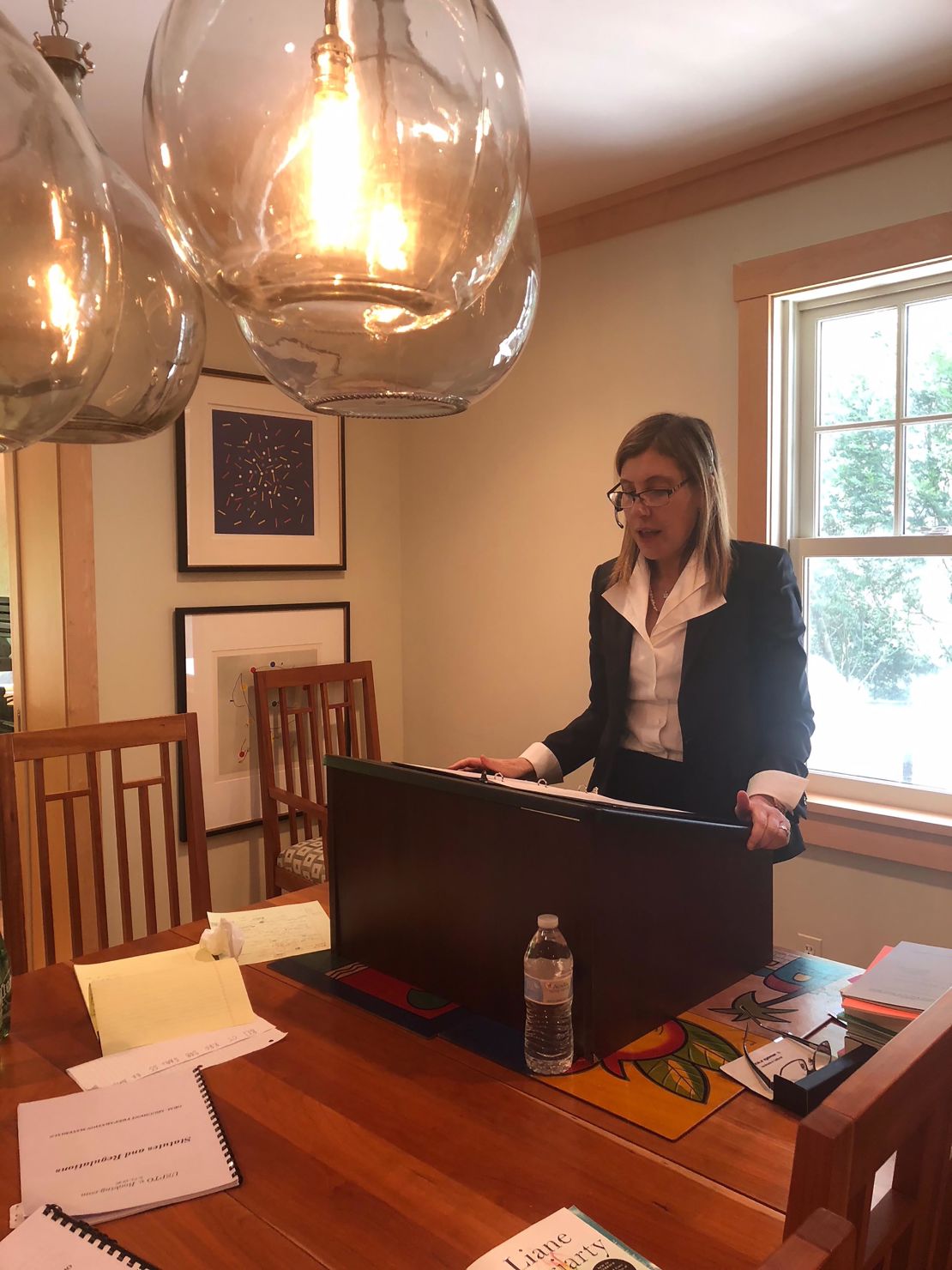It took a global pandemic for the Supreme Court, an institution rooted in tradition and precedent, to change how it conducts its business.
In lieu of the pomp and circumstance associated with the highest court in the land, where lawyers are still presented with quill pens, television cameras are not allowed and only those lucky enough to get inside the building can hear the proceedings live, Monday morning the justices conducted their business over a simple fiber optic cable.
And for the most part, things went well.
To some, a teleconference is the new normal as the world grapples with social distancing, but for the justices and arguing counsel, the change will impact how the court digests its cases and how the lawyers prepare.
“I never thought the day would come when high on my list of pre-argument worries was how to keep my dog from interrupting,” veteran lawyer Lisa Blatt, who will argue the first case, told CNN beforehand.
On top of that, the justices also broke another tradition: they let the public listen in real time. Numerous outlets, including CNN.com, aired the proceedings live.
And in a rare occurrence, Justice Clarence Thomas asked questions of Justice Department attorney Erica Ross and Blatt. Thomas has in the past gone years without asking questions during oral arguments.
The experiment began Monday morning at 10:00 a.m. ET. And all in all, on the first of six arguments sessions planned over the next two weeks went well.
In general, as the justices started off, they sounded a little stilted compared to arguments in the courtroom, but as they warmed up the sounded more natural.
There was one early glitch when Chief Justice John Roberts called upon Justice Sonia Sotomayor and there was silent on her end of the phone for a moment. But then she piped in “Sorry, Chief,” and began her questions.
Roberts kept the time much more strictly than he usually does, cutting off lawyers so the next justice could speak. Kagan seemed the most accustomed to the teleconference, she asked several questions and had more give and take with the lawyers.
The court will work out the kinks in a couple of under-the-radar cases to start, but will build toward some of the biggest cases of the term – including the duel over President Donald Trump’s financial and tax records.
Everybody takes their turn
Roberts often notes that the court’s unofficial mascot is the bronzed tortoise that can be found at the base of the court’s exterior lampposts. The chief likes to say that the court moves gradually and intentionally, like its mascot.
But Covid-19 has prompted a quick change.
Whereas on a normal argument day the justices would sweep in to take their places before a crimson curtain, on Monday, the phone line simply opened up.

But the case wasn’t a free-for-all. In the age of the coronavirus, the court tweaked how the questioning played out. Instead of allowing the justices to jump in and ask their questions whenever they feel the urge, on Monday the justices asked their questions in order of seniority, with the chief justice going first.
That may take some getting used to for these nine justices. Ordinarily, oral arguments feature a so-called hot bench. Advocates are allowed two minutes of uninterrupted time to make their case, and then the justices jump in. Sometimes the questions come with such rapid fire that the chief has to step in to play traffic cop.
In an email to attorneys, the court asked people to keep things short.
“Please be concise and responsive to each question so that each Justice will have adequate time for questioning,” the email said. “If there is time remaining once all justices have had the opportunity to question counsel, there may be additional questioning. Arguing counsel are encouraged to keep their own time for argument, so that they can independently determine how much time is remaining.”
Missing the non-verbal cues
The system may have worked to avoid confusion, but it will change the dynamic on the court – and the way cases are argued.
Paul Clement, who will be making his 102nd argument before the court later in the week, said the new process will mark the first time he’ll have to worry about mistakenly being on mute. On the plus side, he told CNN, he won’t have to consider traffic the morning of oral arguments.
At argument, he said, “the biggest challenge will be the absence of visual clues that you can get when seeing the justices on the bench during oral argument. “
He noted that at oral arguments a lawyer can often pick up whether justices are satisfied with an answer by looking them straight in the eye.
“You can also see whether other justices are processing the argument and interacting with each other, especially when it is not your turn at the podium,” Clement added.
Blatt expressed a similar sentiment.
“I will really miss seeing their faces, but I will imagine their faces and where they are sitting when I hear them speak,” she said.
Some traditions didn’t disappear
One of the first things lawyers hear when their case is called is the Marshal of the Court, Pamela Talkin, who will “cry” the court and bang the gavel.
“Oyez! Oyez! Oyez!,” Talkin says in part. “All persons having business before the Honorable, the Supreme Court of the United States, are admonished to draw near and give their attention, for the court is now sitting. God save the United States and this Honorable Court.”
It’s a moment in the proceedings that often serves to mark the court’s respect for history and tradition just before it shapes new precedent.
Over the phone, the “cry” was slightly modified. The “Oyez, Oyez, Oyez” didn’t have the same ring as it does in open court.
At the Justice Department, lawyers met – under appropriate social distancing guidelines – in the office of the solicitor general. They also followed the tradition of wearing morning clothes even though they’re not in court.
As for lawyer Eric Rassbach, he said he, too, will wear a suit. “This is an oral argument after all,” he said.
He is less daunted by missing the non-verbal communication in court. “Telephonic hearings happen all the time in district court and justice still gets done,” he said.
But he decided he will leave home and travel to a nearby law office.
“I am not sure how much respect my 4-year-old will have for the solemnity of Supreme Court proceedings,” Rassbach joked.
Live audio and big cases
Usually, before big cases, the public is left to camp out – sometimes for days – swapping out containers of coffee and stale donuts in order to get a coveted seat inside the court room. Now, instead of having to wait, they can hear the justices in real time.
Next Tuesday, May 12, maybe after any early glitches are worked out, the court will tackle two of the most important cases of the term concerning Trump’s bid to shield his financial records from Congress and a New York prosecutor. The following day, the court will set its sights on the Electoral College and so-called faithless electors.
By then the experiment will be over, and the public may have also learned that oral arguments are sometimes bogged down with legalese that confound even experienced court watchers.
For the justices, oral arguments are important, but they rely much more on the written briefs in the case as well as friend of the court filings by interested parties.
But whatever else, the justices will have set new precedent.
Back in 1793, according to Clare Cushman of the Supreme Court Historical Society, the justices, alarmed by reports of a yellow fever outbreak, fled Philadelphia, where the court was convening argument sessions. In 1918, in the midst of the Spanish Flu, the justices again postponed arguments.
“We have been adjourned on account of the epidemic as it was not thought right to require lawyers to come, often across the continent to a crowded and infected spot,” Justice Oliver Wendell Holmes wrote in a letter, according to Cushman.
Now, staring Monday morning, the justices – a majority of whom are 60 and above – will not have to worry about infection. Just stay on the line. And don’t forget to mute when it’s not your turn to talk.
After all, as the court said in an email to lawyers: “We encourage counsel to mute themselves as well until it is their turn to argue.”
UPDATE: This story has been updated with details from Monday’s arguments and questions from Justice Clarence Thomas.








